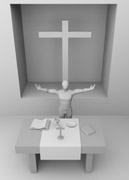Full disclosure here: I’m a vegetarian myself, and not because I don’t like bacon; it’s because I read a compelling argument in a book years ago by Anglican bishop John V. Taylor entitled Enough Is Enough. Though out of print today, it convinced me that the raising of beef cattle at the current staggering quantities is an unjust use of land and resources in a limited world. Also, reading about contemporary pig- and chicken-farming practices made me rethink, from an ecological standpoint, what the things we eat and the way we eat them mean to the water supply and the overall quality of life for nearby humans and animals. In the end, it was information from the Center for Science in the Public Interest forced me to recognize that a meat-burdened diet was no good for me—never mind the planet or my fellow creatures.
This accumulated knowledge comes down to a matter of justice, which is a Catholic concern. If we overtax our natural resources at the expense of our poor neighbors, requiring them to grow feed for our animals when that activity deprives them of the land to grow crops to sustain themselves, and if this same obsession is needlessly cruel to animals and is actually detrimental to our own health, then we are doing something immoral.
What does the Bible have to say? The original arrangement, according to Genesis, follows a vegetarian code. God says in Genesis 1:29-30: “See, I give you every seed-bearing plant all over the earth and every tree that has seed-bearing fruit on it to be your food; and to all the animals of the land, all the birds of the air, and all the living creatures that crawl on the ground, I give all the green plants for food.” That is pretty specific, as the planetary diet goes. Creatures are to eat nonsentient life forms. If it’s aware, it ought not to be consumed.
But the dietary code changes, if you follow the story line. By Genesis 9, after Noah survives the flood and rescues the animal kingdom from extinction, God acknowledges that the world is different. Fear of humanity and its dominance is now decreed for all animals. “Every creature that is alive shall be yours to eat: I give them all to you as I did the green plants.” Only flesh with its lifeblood still in it is remained under the ban (Genesis 9:3-4).
In an age where our preference for meat threatens the welfare of our less fortunate sisters and brothers, it is debatable whether our daily burger is a morally acceptable indulgence.
Editor’s note: Roman Catholic teaching on animals is part of the church’s overall doctrine on “respect for the integrity of creation,” as the Catechism of the Catholic Church says (see nos. 2415-2418). Animals are God’s creatures and so “by their mere existence they bless him and give him glory.” Like all creation, including inanimate nature, animals are “destined for the common good of past, present, and future humanity.”
And like all of creation, God cares for animals, and so human beings should as well. Human treatment of animals cannot be separated from moral considerations; it involves responsibilities as well as rights. Human dominion over nature must also include stewardship. So, the Catechism says, “It is legitimate to use animals for food and clothing. They may be domesticated to help man in his work and leisure. Medical and scientific experimentation on animals is a morally acceptable practice if it remains within reasonable limits and contributes to caring for or saving human lives.”
But there are limits: “It is contrary to human dignity to cause animals to suffer or die needlessly. It is likewise unworthy to spend money on them that should as a priority go to the relief of human misery. One can love animals; one should not direct to them the affection due only to persons.” The bottom line: You may use, but don’t abuse.
Scripture
• Genesis 1:29-30; 9:3-7
Online
• All-creatures.org: Working for a Peaceful World for Humans, Animals, and the Environment
Books
• The Church and the Animals (Catholic Authors Press, 2005)
• Evolution, Animal ‘Rights,’ & the Environment by James B. Reichmann, S.J. (Catholic University Press, 2000)
Reprinted with permission from PrepareTheWord.com. ©TrueQuest Communications.





